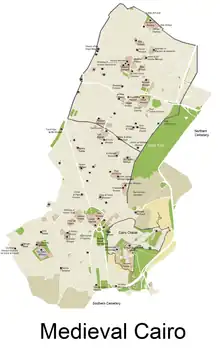
.jpg.webp)
The Madrasa of Uljay al-Yusufi (Arabic: مدرسة ألجاي, romanized: Madrasa Uljāy) was built in the area between Bab Zuwayla and the Cairo Citadel during the reign of the Mamluk sultan Al-Ashraf Sha'ban.
Founder
The amir Uljay al-Yusufi was one of the junior mamluks of Al-Nasir Muhammad who came to power during the late fourteenth century. He had been appointed to the highest rank (muqqadam alf) during the second reign of An-Nasir Hasan, but it was his marriage to a member of the royal family that gave him influence and power. His rise was linked to his marriage to Al-Ashraf Sha'ban's mother, Khawand Baraka, whom he married sometime after her husband's death in 1363.[1] He finally was appointed to the highest military office of commander of the army (atabak al-'asakir) in 1373, but only after the death of Manklibugha al-Shamsi.[2] It was after this promotion he most likely founded his college (madrasa) in Cairo.
Historical Background
The college provided lessons in the Shafiʽi and Hanafi legal schools. It also included a library (khazanah kutub) and was home to famous scholars and teachers. According to al-Maqrizi, Uljay al-Yusufi founded his madrasa sometime in 1366-67 (768 AH).[3] However the foundation inscription on his college reads:
"Has ordered the construction of this mosque and the blessed madrasa, his Excellency, the noble, the lofty, the lordly, the amir Saif al-Din Uljay, commander in chief of the victorious army of al-Malik al-Ashraf (Sha'ban), may God glorify his victory. Dated the month of Rajab in the year 774 /December 1372-January 1373."[4]
However, it is most likely that Uljay al-Yusufi founded this institution after he became the most powerful amir when he had acquired the necessary influence and wealth to create it.
References
- ↑ al-Maqrīzī, Aḥmad ibn ʻAlī (1997). ʿAṭā, Muḥammad ʿAbd al-Qādir (ed.). al-Sulūk li-Maʿrifat Duwal al-Mulūk (in Arabic). Beirut: Dār al-Kutub al-ʿIlmīyah. p. 4:238.
- ↑ al-Maqrīzī, Aḥmad ibn ʻAlī (1997). ʿAṭā, Muḥammad ʿAbd al-Qādir (ed.). al-Sulūk li-Maʿrifat Duwal al-Mulūk (in Arabic). Beirut: Dār al-Kutub al-ʿIlmīyah. p. 4:352.
- ↑ al-Maqrīzī, Aḥmad ibn ʻAlī (2002). Sayyid, Ayman Fuʼād (ed.). al-Mawāʿiẓ wa-'l-iʿtibār fī dhikr al-khiṭaṭ wa-'l-āthār (in Arabic). London: Muʾassasat al-Furqān. p. 4:615-16.
- ↑ O'Kane, Bernard. "The Monumental Inscriptions of Historic Cairo". Insc. Number 131.1.
